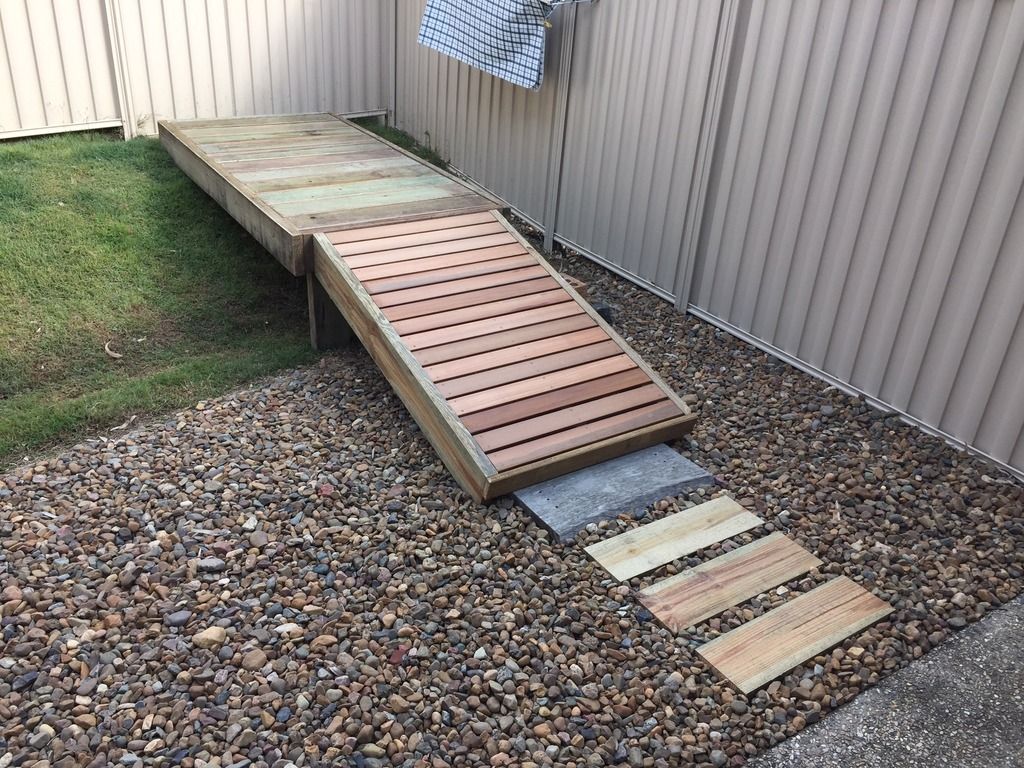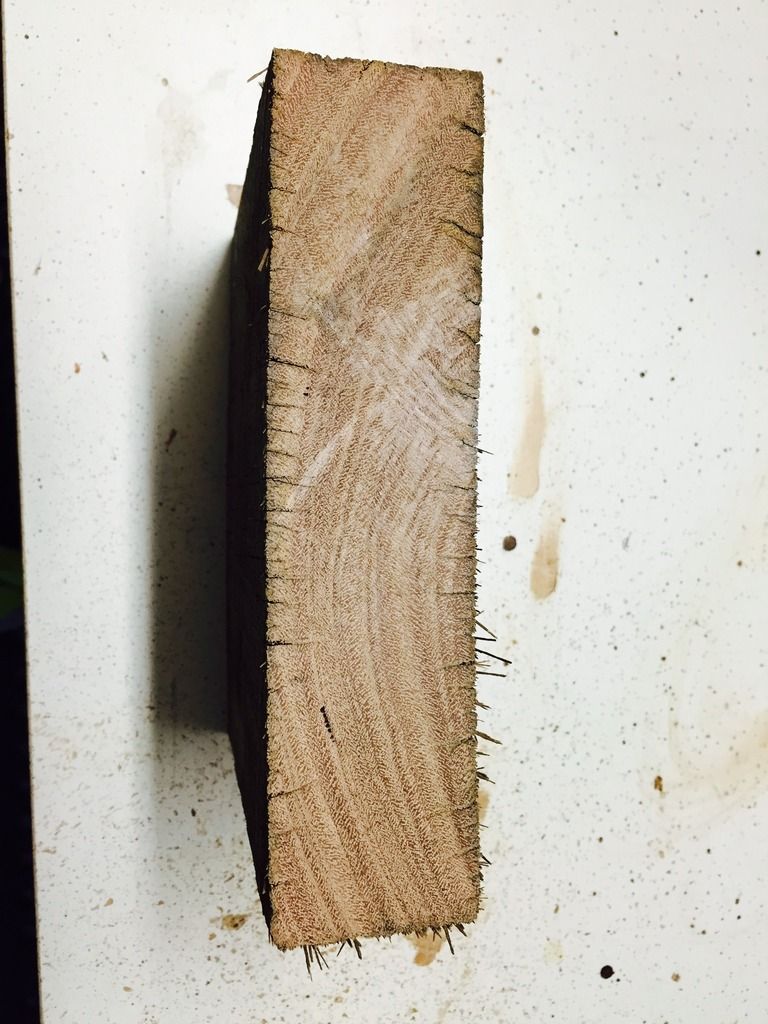 Needs Pictures: 0
Needs Pictures: 0
 Picture(s) thanks: 0
Picture(s) thanks: 0
Results 1 to 15 of 20
-
30th July 2015, 02:42 PM #1
 New Member
New Member











- Join Date
- Jul 2015
- Location
- Sunshine Coast
- Posts
- 6
 CCA Treated hardwood advise please
CCA Treated hardwood advise please
Hi All,
Looking for a bit of advise here please.
I'm about to build a freestanding heavy bench for myself and have access to some 200x50x2400 hardwood sleepers. The trouble is, I know they are CCA treated and I've seen on the wonderful Dr. Google that the chemicals has a carcinogenic risk. Understanding the documentation is rather complicated (or I'm just a bit slow...).
Question is, once built (i.e. not taking the sawdust etc of building it into consideration) how much of a risk does it pose? Would you feel comfortable working on a CCA treated bench? How would you minimise risk? Is this a storm in a teacup or would you avoid it like the plauge?
Any suggestions?
Thanks!
-
30th July 2015 02:42 PM # ADSGoogle Adsense Advertisement
- Join Date
- Always
- Location
- Advertising world
- Posts
- Many
-
30th July 2015, 02:57 PM #2
 SENIOR MEMBER
SENIOR MEMBER











- Join Date
- Sep 2013
- Location
- Jarrahdale WA
- Posts
- 370
 Here in WA
Here in WA
the home of termites, I still have not come across CCA treated hardwood, so not even sure it is actually a thing.
How do you know
A: its treated?
B: it's hardwood?
Possibly it could be creosote treated, more likely, which has only been recently been banned here in Aus. You'll know from it's unique, not unpleasant smell.
However that all pans out I would not have any great problem with working on a CCA treated bench. It's really the dust thats the problem, and using a bench means not much of that really...but making it means masks etc...
-
30th July 2015, 03:23 PM #3
 New Member
New Member











- Join Date
- Jul 2015
- Location
- Sunshine Coast
- Posts
- 6
 CCA Treatment
CCA Treatment
Hi David,
Thanks for the response, appreciate your input.
I am sure it's hardwood (visually confirmed) and there are CCA labels stapled on the end.
The suggestion I see often on the web, to reduce risk, is to paint the wood once a year or so with a penetrating oil type product. My feeling is that the warnings are extremely overstated (possibly to avoid liability claims?) but then, I'm no chemist and I suppose it's always sensible to do things with as low a risk as possible. It's the finding the point between ridiculous and real risk that is hard to do.
-
30th July 2015, 04:10 PM #4

Hi,
I had similar concerns when using treated pine for practicing joinery on. Googled everything I could and checked out the msds, from what I could find it's essentially harmless unless burnt which is when it will give off toxic fumes. I too think there is a tendancy to over react on this matter, then again I drink out of plastic bottles and use aluminium cookware.
Regards Bart
-
30th July 2015, 09:55 PM #5

The main concern is for the arsenic content. The CSIRO guide is to try to eat less than a half kilo of CCA timber a month - if you do that, you'll stay within your bodies ability to process the arsenic out. Note that there are suburbs in Australia where naturally occurring arsenic levels in soil are higher than you get near CCA treated timber.
To me, CCA treated timber (with a 50+ year history) is safer than the other, newer treatments - and a layer of paint will lock the CCA away, anyway!
(and according to the "information we make up is just as good as science" health brigade, only pure titanium cookware is safe!!)
-
30th July 2015, 11:35 PM #6
 Member
Member











- Join Date
- Jul 2013
- Location
- Melbourne
- Posts
- 53

"The CSIRO guide is to try to eat less than a half kilo of CCA timber a month "...
That's good to know. I will make sure to limit my side dish of CCA timber with my dinner from now on.
-
31st July 2015, 12:34 PM #7
 New Member
New Member











- Join Date
- Jul 2015
- Location
- Sunshine Coast
- Posts
- 6

@Master Splinter; Thank you, great information and the link was articulately useful. As per Markdem, I'll cut down on my CCA side dish and concentrate more on my veggies from now on.
-
1st August 2015, 02:27 PM #8
 SENIOR MEMBER
SENIOR MEMBER











- Join Date
- Jun 2009
- Location
- Elizabeth Bay / Oberon NSW
- Age
- 76
- Posts
- 934

Copper & Arsenic are toxic and Chromium is a carcinogen. Toxicity is all about dosage rates so, as others have said, it's wise to eliminate toxins from your diet.
Carcinogens are an entirely different matter because no medical person will provide a minimum safe exposure level to a carcinogen. Hence the panic about asbestos despite it being used in clutch & brake pads well into the 1990s and post-mortem studies reveal that we all have asbestos fibres in our lungs.
A tiny proportion of people are allergic to CCA.
The amount of CCA in your timber is negligible. Good luck with your bench!
mick
-
1st August 2015, 03:27 PM #9
 New Member
New Member











- Join Date
- Jul 2015
- Location
- Sunshine Coast
- Posts
- 6

Thanks everyone, great info.
Level headed response Mick, I'm going ahead with the wood I have. Will need to get treated pine resistant hardware as all I have is galvanised.
Now all I have to worry about is the asbestos in my lungs....
-
5th August 2015, 03:57 PM #10
 GOLD MEMBER
GOLD MEMBER

- Join Date
- May 2015
- Location
- Brisbane
- Posts
- 1,153

If you are at all worried about the chemicals then the CCA hardwood is better to use than the softwood. The treatment process involves putting the timber in a vacuum tank and then flooding the tank with the chemical so in the case of softwood the mixture is drawn into the timber as far as the heartwood. But with hardwood there is no draw in process so only the outer 1-2mm is treated. Once you cut a piece you will see. I made this sun deck for my dogs out of hardwood from a retaining wall I demolished. You can see what I mean by the heartwood in the pine I used for the ramp.

-
5th August 2015, 08:17 PM #11
 Member
Member











- Join Date
- Aug 2008
- Location
- melbourne
- Age
- 74
- Posts
- 76
 Cca poses health risks
Cca poses health risks
Well I am not going to join in the chorus of CCA sceptics, because the APVMA ( the Gov't body responsible for regulating chemical use) banned CCA treatment in about 2005.
The ban applies to picnic tables, handrails, outdoor seating and playground equipment. The reason for the ban was that there were significant health risks from touching a treated surface and then eating, smoking, licking fingers etc. Children are particularly at risk, and there is evidence that their brain development can be affected. If you want expert info, google Professor Sharon Beder of Wollongong Uni.
THe CSIRO can't be considered an impartial authority, because they helped develop these chemical treatments, and work with the industry.
The treatment continues to leach out of timber for years, and painting is only a temporary protection. I would like to see some measurement of depth of penetration in hardwood, before accepting that it only a few mm.
It would be better to use untreated timber for the benchtop.
-
5th August 2015, 08:43 PM #12
 GOLD MEMBER
GOLD MEMBER

- Join Date
- Jan 2013
- Location
- the sawdust factory, FNQ
- Posts
- 1,051

"Negligible penetration of heartwood by currently available commercial processes" is the exact phrasing used. The cellular structure of heartwood doesn't allow the chemical through the cells walls easily, and under a H3 schedule you'll be hard pressed to get 2mm of treatment zone. H5 gets you all of 5 mm at best, and that requires double dipping and a long period under positive pressure in the chamber. Note that that's heartwood, there should be full penetration of sapwood.
I personally detest CCA and don't use it myself, and would financially benefit if the stuff was banned. But it is the best timber treatment out there in terms of low risk long term timber preservation. There are better timber preservatives, and there are safer timber preservatives, but it really does hit the intersection of those two curves better then any other treatment solution.
There are risks for sure: It kills stuff that eats it, including dogs and people - but yanno that's the whole point. Teach your dogs and kids not to eat the furniture.
-
6th August 2015, 12:58 AM #13
 GOLD MEMBER
GOLD MEMBER











- Join Date
- Dec 2010
- Location
- Mornington Peninsula
- Posts
- 2,750

I must admit that in these situations, I tend to favour the cautious approach.
Personally, I would not use it.
-
6th August 2015, 07:35 PM #14
 GOLD MEMBER
GOLD MEMBER

- Join Date
- May 2015
- Location
- Brisbane
- Posts
- 1,153

During the 90's i worked for CSR Timber and CCA Timbers and it was my job to make people buy this stuff, and people did by the millions of cube, and while the process is dangerous and prolonged use without protection might be dangerous, one off or casual use will not have any lasting effects and to prove a meaningless point i once worked with a guy who while extolling the virtues of CCA would happily chew on a piece of it to prove that questions about its safety were not necessary.
So to prove my point i went and cut a piece of 8 year old CCA treated hardwood to show you how little hardwood will ingest treatment. If you bury a cut edge in the ground the termites will feast on it.

-
7th August 2015, 12:07 PM #15
 Member
Member











- Join Date
- Aug 2008
- Location
- melbourne
- Age
- 74
- Posts
- 76
 Chewing on cca treated timber
Chewing on cca treated timber
DoubleD,
The image of your workmate chewing on a piece of CCA treated timber, as part of his sales pitch, reminds me of the film SILENT SPRING, based on the book by renown marine biologist Rachel Carson. In the film, a representative of the chemical company producing DDT in the 1950's, got so carried away with his message that the chemical was harmless that he started eating the powdered concentrate. I don't know if this convinced his audience at the time, but it was a pathetic demonstration of the fact that long term health damage cannot be predicted by short term testing. When a producer of a new product assures us that it has been thoroughly tested, it is probably only limited, short term testing. I remain sceptical.
Similar Threads
-
treated hardwood - uses??
By tomnewby in forum TIMBERReplies: 8Last Post: 27th April 2009, 09:53 PM -
Treated hardwood can you tell?
By Tiger in forum TIMBERReplies: 28Last Post: 2nd January 2009, 09:59 AM -
Hardwood vs treated pine
By nuggett_aus in forum TIMBERReplies: 5Last Post: 13th May 2008, 10:41 PM -
Treated v's Hardwood Structural Timber
By Dalob in forum TIMBERReplies: 4Last Post: 3rd April 2007, 11:00 AM



 Thanks:
Thanks:  Likes:
Likes: 
 Reply With Quote
Reply With Quote
